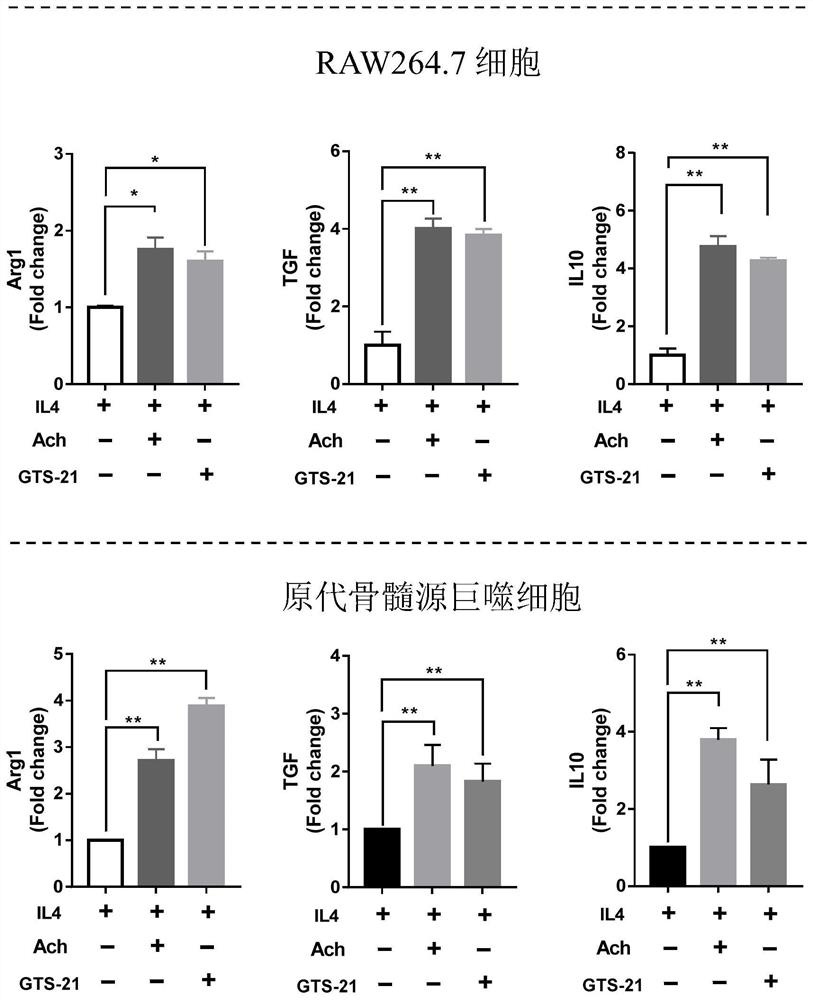Method for regulating polarization state of macrophages
A technology of macrophages, polarization state, applied in the field of biomedicine
- Summary
- Abstract
- Description
- Claims
- Application Information
AI Technical Summary
Problems solved by technology
Method used
Image
Examples
Embodiment 1
[0049] Example 1 Isolation and cultivation of bone marrow-derived macrophages
[0050] The mice were killed by neck dislocation, and soaked in two 75% alcohol beakers in turn; the thigh was cut off with scissors, the femur and tibia were separated, and the skin and flesh were removed and placed in 10 mL RPMI1640 medium (containing 10% FBS); the femur and tibia were cut On the articular surface, expose the bone marrow cavity, flush the bone marrow cavity with a 10mL syringe (1mL needle), and blow off the cells with a 1mL pipette gun;
[0051] After the cells were filtered through a cell sieve, the cell suspension was collected into a 50 mL centrifuge tube; centrifuged at 1000 g for 8 min, the supernatant was discarded, and the cells were resuspended in 1640 medium containing 10 ng / mL macrophage colony-stimulating factor (MCSF), and inoculated on 6 After three days, a medium containing 10 ng / mL MCSF was added, and the mature bone marrow-derived macrophages (BMDM) obtained after ...
Embodiment 2
[0052] Example 2 Effects of acetylcholine and cholinergic receptor agonists on M1 macrophages
[0053] RAW264.7 or BMDM were inoculated in 6-well plates, and when the cell density reached about 70%, different concentrations of acetylcholine (0, 10, 50, 100, 200 μM) or cholinergic receptor agonist GTS-21 were added (0, 5, 10, 20, 50 μM) for 10 minutes;
[0054] M1 macrophages were induced by lipopolysaccharide LPS or IFNγ stimulation, and the cells were collected 24 hours later to analyze the expression of pro-inflammatory factors TNFα, IL-1β and IL-6.
[0055] The result is as figure 2 As shown, in LPS-induced RAW264.7 cells, they were treated with different concentrations of acetylcholine (Ach) and GTS-21 for 24 hours, and then the relative expressions of pro-inflammatory factors TNFα, IL-1β and IL-6 were analyzed. The results It was shown that the pro-inflammatory factors induced by LPS could be inhibited by acetylcholine and GTS-21 in a concentration-dependent manner. S...
Embodiment 3
[0056] Example 3 Effects of acetylcholine and cholinergic receptor agonists on M2 macrophages
[0057] RAW264.7 or BMDM were inoculated in 6-well plates, and when the cell density reached about 70%, acetylcholine or cholinergic receptor agonist GTS-21 was added to treat for 10 minutes;
[0058] M2 macrophages were induced by IL-4 stimulation, and the cells were collected 24 hours later to analyze the expressions of anti-inflammatory factors arginase 1 (Arg1), TGF-β, and IL-10.
[0059] The result is as image 3 As shown, in IL4-induced M2 macrophages RAW264.7 and primary bone marrow-derived macrophages, acetylcholine (Ach) and GTS-21 can significantly promote the differentiation of M2 macrophages, and promote the expression of related marker genes such as Arg1. , TGF and IL-10 expression.
PUM
 Login to View More
Login to View More Abstract
Description
Claims
Application Information
 Login to View More
Login to View More - R&D
- Intellectual Property
- Life Sciences
- Materials
- Tech Scout
- Unparalleled Data Quality
- Higher Quality Content
- 60% Fewer Hallucinations
Browse by: Latest US Patents, China's latest patents, Technical Efficacy Thesaurus, Application Domain, Technology Topic, Popular Technical Reports.
© 2025 PatSnap. All rights reserved.Legal|Privacy policy|Modern Slavery Act Transparency Statement|Sitemap|About US| Contact US: help@patsnap.com



